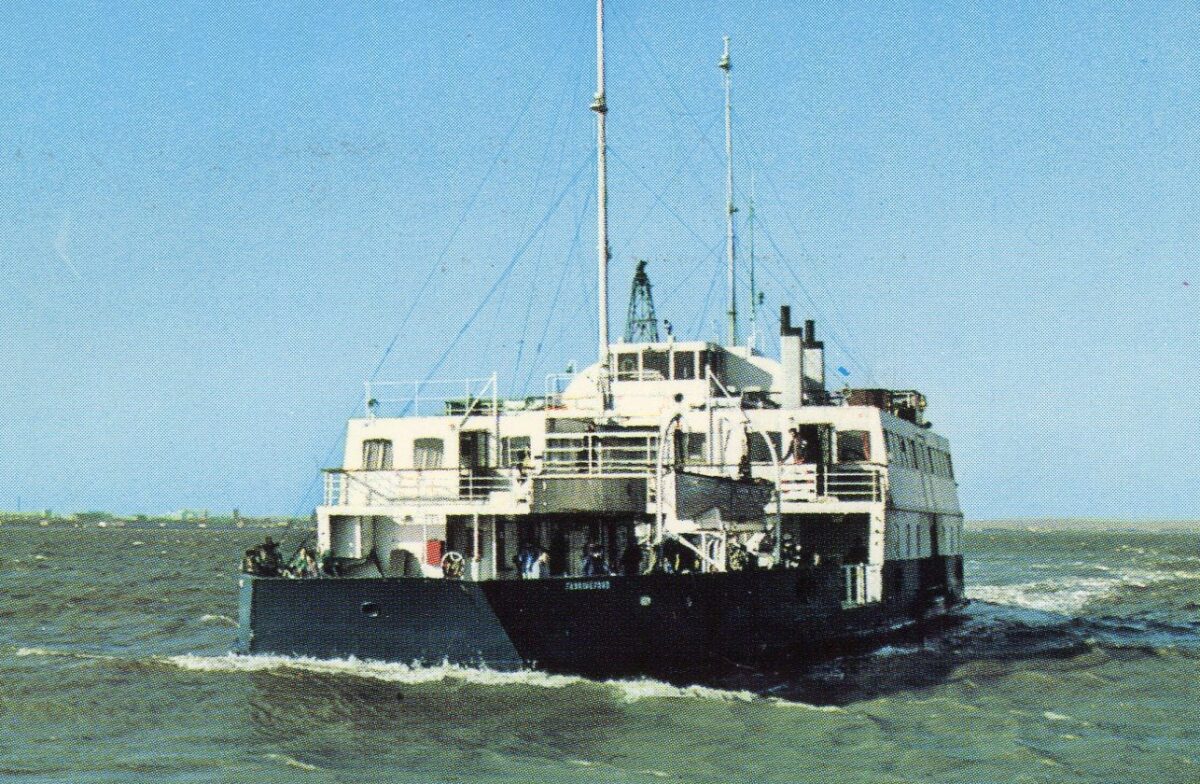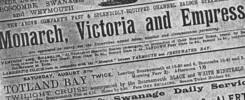
It is a very commonly held view which I have heard very many people express over very many years, that paddle steamers were not permitted to use independently operating paddle wheels whilst carrying passengers following an alleged accident in which a paddler had apparently capsized by putting one wheel ahead and the other astern. Watching this little weed eating vessel (pictured above) dredging the bottom of the harbour at Como in early February 2004 and spinning round in her own length with her independent wheels, reminded me of this. Yet if it was true that passenger carrying paddlers could not have independent wheels then why should it not also be true for non-passenger carrying paddlers? Why should the one be any more likely to turn over than the other? And this little vessel seemed to have absolutely no stability problem spinning round on a sixpence with the starboard paddle going flat out one way and the port going flat out the other.

Then what about the paddlers which did have independent wheels and which did carry passengers? For example, four Diesel electric paddlers, including the Grafin Cosel (pictured above), were built with independent wheels in 1963/64 for service on the River Elbe from Dresden. I recall standing on the decks of one of these in the early 1990s and watching her spin round in the river in her own length with one paddle going full ahead and the other full astern. Yet she didn’t show any sign of wanting to capsize. Nor could it be said that these paddlers were short and fat and therefore more difficult to turn over. At 69.91m in length, with a hull width of 7.8m and a draught of only around 1m they were distinctly on the slender, not to say tender, side and, with a length to beam ratio of 8.9, were proportionately longer, thinner and shallower draft and therefore inherently less stable than many British excursion paddle steamers including Waverley and Kingswear Castle.

Then there was the Farringford (pictured above) built in 1947 for the railway service from Lymington to Yarmouth. Although not looking like everyone’s idea of a beautiful paddler she nonetheless carried passengers and vehicles, had passenger certificates and was propelled by independent paddle wheels which were operated independently in passenger service.

Then there were the Woolwich Ferries, Squires, Gordon, John Benn (pictured above) and Will Crooks; the Dundee paddler BL Nairn, the Forth Ferries Queen Margaret, Robert the Bruce, Mary Queen of Scots and Sir William Wallace; the Neyland paddler Cleddau Queen, the list goes on and on and all had independent paddle wheels which were used independently in service whilst carrying passengers.
So is this story of an accident and a ban just an urban myth, something which sounds plausible, sounds as though it should be true but isn’t? And if there was a ban how come there were so many paddlers which defied it? Did they have some special exemption? And what of this alleged accident? What ship did it involve? When was it? The literature on British excursion paddle steamer history covering the last one hundred and thirty years or so is quite comprehensive yet none of it records any such an accident happening anywhere in the UK. But what of before that? What about elsewhere? Does anybody out there have any more detailed information? Can anyone shed any further light on this interesting debate?
Mike Ledger wrote on 5th February 2004:
An interesting debate, John. As a professional mariner I have always understood that independent paddles were forbidden for the aforementioned reasons EXCEPT for Naval tugs, the last class being the Director Class of the 1950’s. Maybe the powers that be in the MoT thought that we mere Merchant Service mortals were totally unfit to operate such a lethal piece of machinery.
An interesting sideline concerns stabilizer fins – Denny models in the 1960’s were fitted with a “Manual” control knob on the Bridge control module but it was lockable and the key was kept by the Master because, yes, you’ve guessed, it was possible to capsize the ship if done by a lesser mortal. I never saw it used, probably because the ensuing paperwork would have been something to behold, but have heard that it can produce an alarming roll in calm water – great for keeping the messing rate down on a passenger ship!
Mike Ledger wrote again on 9th February 2004:
Further to my last message I have searched my extensive library and can so far only come up with a quote from Kemp’s Oxford Companion to Ships & the Sea to the effect that “…as paddle tugs carry no passengers, they are permitted by law to be able to disconnect the shaft and to work each wheel independently of the other.”
The Admiralty Director class of tugs were definitely independently controlled.
Finally, in the unlikely event that you aren’t already aware of it, I came across a fascinating website about New Zealand paddle steamers on
www.riverboats.homestead.com. Saw a reference to independent paddles on a linked site but damned if I could find it in the text (reference was given in a Google title).
And again later the same day:
Bill Hannan’s “Fifty years of Naval tugs” states “In harbour paddle wheels were used independently but for safety at sea it was necessary to clutch the two paddle shafts together to prevent racing should one wheel be lifted out of the water. It also helped to stabilize steering.”
Andy Munns wrote from Australia on 18th March 2004:
The story I heard was that the paddle/crankshaft concerned was fitted with a clutch – OK for smooth waters but overstrained in a seaway where you would have differing immersions.
The story went that the clutch failed and the paddler turned under the bows of another vessel before it could be stopped??
Hard to say what the real story is as I think the engineer could have reversed the engine and remaining paddle very quickly pulling the vessel back away from the other vessel?
Might be the old urban myth syndrome like welders and contact lenses….
Yours in steam
And finally from Dave:
It’s my thought & feeling that the independent wheel ban was NOT for reasons of stability, but because one wheel could go deep and become very hard to turn whilst the other would come out of the water and turn freely, allowing the engine to overspeed and damage itself.The solution was to lock them together at sea and release them for maneuvering. The only “wheeler” of which I am familiar had this feature, called an “Antirunaway valve linkage”.
Kingswear Castle returned to service in 2023 after the first part of a major rebuild which is designed to set her up for the next 25 years running on the River Dart. The Paddle Steamer Kingswear Castle Trust is now fund raising for the second phase of the rebuild. You can read more about the rebuilds and how you can help if you can here.
John Megoran


